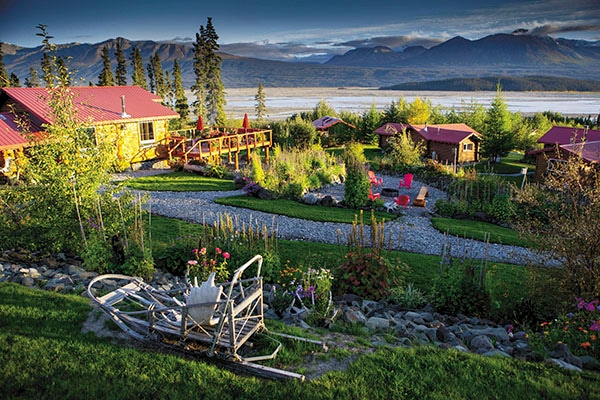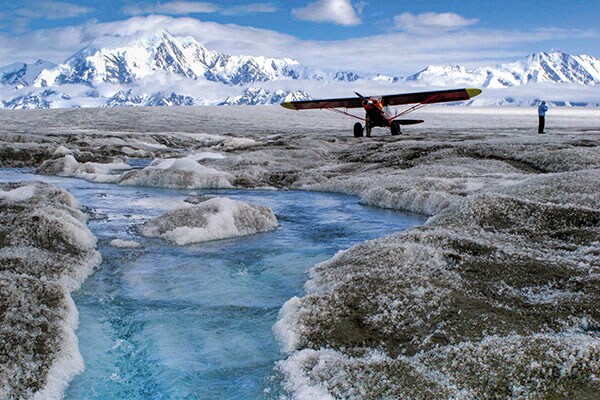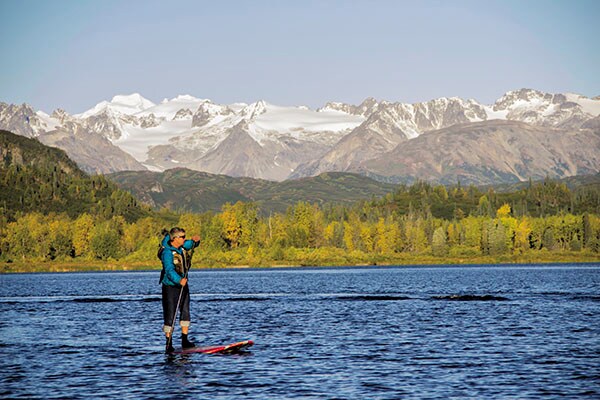The next frontier: Alaska's luxury lodges
From the wildest heli-hiking to the tastiest trout fishing, the state of Alaska's luxury lodges


Alaska is hands down the most exotic you can get in America without a passport, a northerly paradise where the mountains are twice as big, the skies twice as vast, the days twice as long (or don’t happen at all), and the best places are exponentially more remote. Nature, at its most epic and glorious, is still king here, with the state accounting for more than half of the US’s protected wilderness areas. Locals don’t mention highway numbers, as there’s basically just one major artery, which runs in a loop from Anchorage to Fairbanks and Denali, that everyone simply calls “the road”.
While plenty of cruise ships ply the waters of the southeastern panhandle, and a good number of visitors opt for camper vans or cheap and cheerful cabins with shared bathhouses, the quintessential luxury Alaska is found by going off-road. Catering to sportsmen and photographers, the best lodges are reached only by floatplane, helicopter or 12-seater Cessna—which makes the fact that people managed to build these outposts of refined rusticity all the more remarkable. Here are three of the finest.
Ultima Thule Lodge
Quite possibly the most isolated lodge anywhere, Ultima Thule Lodge takes its name from the “unknowable realm” beyond the northern bounds of ancient Greek maps (and a Longfellow book inspired by same). Getting there requires perseverance: A six-hour drive northeast from Anchorage to Chitina, then a 90-minute flight from the airstrip to the lodge, in the Wrangell-St Elias Wilderness. By the time we arrived, the other 11 guests and I were congratulating ourselves for having made it.
Paul Claus (who has more than 35,000 hours of flight time), his son, daughter and son-in-law are among them. Paul and his wife, Donna, made this land their permanent home in 1982 and began building the lodge. It’s a big step up from the rough cabin John built with two Eskimos, but some of the logs from that simple home are in the main lodge. Donna, a former champion ski racer, runs the kitchen—starting with the fluffy scones she pulls out of the oven around dawn.
The place is improbable, operated by a family that has spent over three decades in the middle of nowhere—more than 100 miles from the nearest road—but is worldly, eager to converse about their Africa travels and ready to cater to guests who are accustomed to a certain standard of comfort.
Adding to the appeal is that everything here got here via a small steel tube. (Everything: When the Chitina River changed course, forcing the Clauses to relocate some cabins, one of their crack pilots managed to land a C130 carrying an earthmover on a strip of ice.)
Those cabins, cocoons that they are, are the base camp for Ultima Thule’s distinct brand of adventure. Each day, guests climb into two- and four-seater planes and set off wherever their pilots suggest: Flightseeing, hiking, wildlife spotting, fishing, rafting and backcountry skiing in spring. The playground is the Wrangell-St Elias National Park, which at more than nine million acres of tundra, glaciers, volcanoes and coastal mountains, is the largest protected wilderness in the world. The massive Mount St Elias is 17,000 feet of vertical rock (arguably taller than Everest, which starts at a higher elevation), and guests have found sea fossils on lesser peaks.
The pilots can get guests pretty much anywhere—Paul Claus parked our plane in a dry riverbed and led me on a hike to a hidden cave on the side of a mountain (discovered on a staff geocaching adventure), flew us to a meadow full of wildflowers, landed on a glacier where we walked over to see the remains of an old mining camp and soared by mountain peaks on our way home.
The Claus family makes everything look easy, but Paul begins every trip with a warning. The only given in the wilderness will be unpredictability. He calls it the Alaska Factor: “Everything is bigger, larger, greater—and tougher than it looks. It doesn’t matter who you are or what you’ve done. If you come here, you’ll contend with the Alaska Factor.”
Tordrillo mountain lodge
Olympic gold medallist Tommy Moe was ski royalty when he and some friends headed into the Tordrillo Mountains, about 60 miles west of Anchorage, with a Bell Jet Ranger helicopter and ten barrels of jet fuel nearly 20 years ago for a week of corn skiing and king salmon fishing. By the end, they knew they wanted to return—and were sure others would follow.
Since then, the partners, who also include Alaska heli-ski pioneers Greg Harms and Mike Overcast, have turned Tordrillo Mountain Lodge, on the banks of Judd Lake and the Talachulitna River, into one of the most acclaimed bases for exploring and adventuring. The topflight backcountry guides and pilots are known for pioneering more heli-ski terrain than anyone else in Alaska. Although it’s just a 40-minute floatplane flight from Anchorage, it feels spectacularly remote.
That’s not a coincidence. Several of the owners operate bigger fishing lodges, and Tordrillo is their “toddy house”—where they take their families to escape the fishing tourism scene—built on five acres they self-scouted, on the edge of national forest with views of two 11,000-foot volcanoes and Mount McKinley.
The draws are isolation, excellent fishing and access to terrain that’s challenging for accomplished skiers and other world-class athletes—a recently retired Major League player who pitched a winning World Series game was there during my stay, and Laird Hamilton and Karl Malone are also in the guest book. Hamilton insisted the owners buy a stand-up paddleboard (SUP)for guests to explore the lake and river my guide confessed that it gets little use, SUP being a sport only for those with excellent balance and tolerance for cold, even during my visit in August.Heli-skiing and boarding start during the lengthening days of March and continue into the midnight-sun months, and fly-fishing starts just behind. By late summer, the salmon are spawning in such great numbers that the streams may as well be koi ponds.
There are rich waters right outside or a short jet ski ride away (or SUP if you’re brave), but helicopters also get guests deeper into nature. There’s spectacular heli-hiking, too, like a ramble down a wildflower-dusted mountain slope, where the shrubbery was already beginning to turn crimson, toward a glacial lake whose shores resemble a Richard Serra work in glacial blue. My guide and I walked among the massive, irregular cubes, three times my height, chipped off some chunks and placed them in the baggage hold of the helicopter for G&Ts that night.
As for the lodge itself—where rates start at $1,100 a night in the summer—it’s a 5,600-square-foot log cabin that sleeps 12, with walls of windows, a shared living room, three large cedar decks overlooking the lake and mountains, and a wood-fired outdoor hot tub and sauna. (There is also a second, five-bedroom lodge on the opposite shore of the lake.) An Aman Resort it’s not my room had little more than a bed and some hooks for clothes, but that bed was plush, the shower was hot, and the stunning emptiness of Alaska was right outside.
Favorite Bay lodge
This southeastern fishing lodge isn’t quite as remote at Tordrillo—there are scheduled floatplane flights from Juneau to Admiralty Island, and the nearby community of Angoon is home to a few hundred people—but is no less placid. Favorite Bay Lodge is in a sublime spot on the inside passage, near the Tongass National Forest, and it’s impossible to choose a favourite of the bays that surround it.
As at Tordrillo in summer, fishing is the big draw: Freshwater for Dolly Varden, cutthroat and steelhead trout, and saltwater for salmon and massive halibut. One frequent guest I met proudly showed me his photo with the 375-pound fish he caught several years ago. (It’s impressive enough to be on the lodge’s website.) The guides have spent their lives on these waters. And here guests get to keep much of their haul (though the chef may take some for dinner) rates (which begin at $3,750 for three nights) include processing and shipping up to 100 pounds of fish to Juneau.
But it’s also a full-on luxury lodge, with 12 individually decorated guest rooms with native cedar walls, lodge-pole furnishings, big bathrooms with soaking tubs, handcrafted rugs and excellent bedding. The pretty dining and great room has a sunken fireplace area, double-height ceilings, three full walls of windows and spectacular views over Favorite Bay, especially for late-night sunsets.
The activities extend far beyond rod and reel, with many guests exploring the bays by kayak or motorboat, hiking or scouting out the bald eagles and bears—both are here in huge numbers.
There’s no way I’m going to haul in a 375-pound anything, so I cruised over to a nearby island for a bear-spotting expedition with lodge owner Dana Durand, who built the lodge with profits from his catering business in Monterey, California. This is a be-careful-what-you-wish-for proposition, and I was relieved to come across little more than freshly killed salmon, whose hunters had been scared off by our voices. Seeing the majestic, fearsome animals by boat is enough. Durand happens to be a mycologist, so we stopped off to forage, filling a bucket with a perfect porcini (soon a delicious carpaccio) and so many chanterelles that it was hard to carry.
On the way home, we cruised through the fishing waters of Chatham Strait, where the krill and herring that draw fish also attract humpback whales. Within 15 minutes, we saw a pair fully breach and spin in perfect synchronicity. You couldn’t choreograph a better show.
First Published: Aug 11, 2015, 06:08
Subscribe Now(This story appears in the Jul 16, 2010 issue of Forbes India. To visit our Archives, Click here.)


